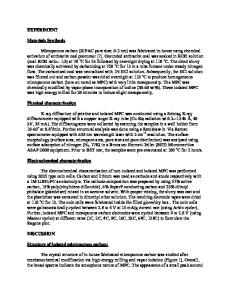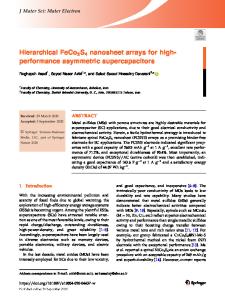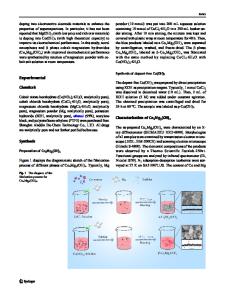Carbon-Halide Nanocomposites for Asymmetric Hybrid Supercapacitors
- PDF / 176,180 Bytes
- 6 Pages / 612 x 792 pts (letter) Page_size
- 80 Downloads / 480 Views
1056-HH03-51
Carbon-Halide Nanocomposites for Asymmetric Hybrid Supercapacitors Prabeer Barpanda, Giovanni Fanchini, and Glenn G Amatucci Energy Storage Research Group (ESRG), Department of Materials Science and Engineering, Rutgers University, North Brunswick, NJ, 08902 ABSTRACT Nanostructured materials and nanocomposites have inspired many structural and functional applications in recent time. In the last decade, energy-storage devices have employed electrode materials in form of nanomaterials/ nanocomposites to yield promising electrochemical performance. The current paper throws light on the application of nanostructured pristine activated carbons as well as chemically modified carbon-halide nanocomposites in practical electrochemical supercapacitors. Pristine activated carbons have been mechanochemically modified via high-energy milling and iodine doping to produce carbon-halide nanocomposites. A significant change in existing physical and electrochemical properties (~200-500% rise in volumetric capacity) has been marked by introduction of iodine into carbon and the subsequent formation of nanocomposites. The effect of halides and nanoscale morphology is discussed using X-ray, Raman spectroscopy, DSC, BET analysis and electrochemical testing. INTRODUCTION With the advent of nanotechnology, nanostructured materials and nanocomposites have attracted tremendous attention focusing on their fundamental properties as well as numerous practical applications ranging from MEMS, biotechnology to electronic devices [1,2]. One such commercially successful usage of nanotechnology is in the broad field of energy storage and applied electrochemistry. The induction of nanomaterials has been reported to achieve highperformance intercalation and conversion materials ranging from transition metal oxides (e.g. LiCoO2, LiMn2O4, LiFePO4 etc) to conversion materials (e.g. BiF3, FeF3, AgF etc) [3,4,5]. Recently, we have developed a new class of carbon-iodide nanocomposites with high energydensity that is promising in commercial electrochemical capacitor usages [6,7]. The Electrochemical double layer capacitor (usually known as supercapacitor) is a leading energy storage device owing to its outstanding power density, robustness and cycling stability [8]. Currently, activated carbons are the most widely used electrodes in supercapacitors due to its economic production and desirable surface morphology. The current work is an endeavor to produce an improved high-performance activated carbon based electrode by physico-chemical iodation and nanocomposites formation. The overall capacity of carbon electrode is a combined mechanism of non-Faradaic charge storage (by electrostatic double layer formation) and Faradaic charge storage (by electron transfer involving redox reaction of electrodes). When a carbon-halide nanocomposites system is fabricated, the highly electronegative halides may induce some degree of charge transfer reaction with carbon, thus modifying its physico-chemical and electrochemical characteristics. Subsequently, carbon-ha
Data Loading...











